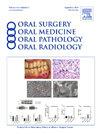Association of fungal sinusitis and endodontically treated maxillary teeth: a systematic review of the literature
IF 2
3区 医学
Q2 DENTISTRY, ORAL SURGERY & MEDICINE
Oral Surgery Oral Medicine Oral Pathology Oral Radiology
Pub Date : 2025-02-04
DOI:10.1016/j.oooo.2024.11.061
引用次数: 0
Abstract
Fungal sinusitis is common in immunocompromised individuals. However, fungal sinusitis still occurs in healthy individuals without risk factors for infection. The disease process of fungal sinusitis is not fully understood but has been thought to be associated with the inflammatory process of odontogenic procedures within the maxilla. The purpose of this systematic review was to evaluate the strength and frequency of the association between fungal sinusitis and endodontically treated maxillary teeth.
We queried PubMed and Google Scholar with the search terms “fungal sinusitis,” “endodontically treated,” “root canal treated,” and “maxillary teeth,” which yielded a total of 42 records. The titles and abstracts were screened to identify manuscripts that described studies investigating associations between fungal sinusitis and odontogenic infection. The manuscripts were reviewed in detail and the numbers of subjects with fungal sinusitis and with root canal treated maxillary teeth were collated. Searches and reviews and data collation was performed following Preferred Reporting Items for Systematic reviews and Meta-Analyses guidelines.
Our systematic review included 5 case-control studies and 6 case reports that provided adequate details on the association between fungal sinusitis and root canal treated maxillary teeth. These manuscripts yielded a total of 399 individual patients with fungal sinusitis. Of these, 217 patients (54.3 %) had at least one endodontically treated maxillary tooth. The average age across all subjects was 57.1 years. 70% of subjects were female. Two studies did not report age and gender distribution. In 2 cases, the sinus infection was bilateral.
Endodontic treatment of the maxillary teeth is a significant risk factor for fungal sinusitis. Oral and maxillofacial radiologists must be aware of this association so they can recognize etiological factors of fungal sinusitis and direct management as necessary.
求助全文
约1分钟内获得全文
求助全文
来源期刊

Oral Surgery Oral Medicine Oral Pathology Oral Radiology
DENTISTRY, ORAL SURGERY & MEDICINE-
CiteScore
3.80
自引率
6.90%
发文量
1217
审稿时长
2-4 weeks
期刊介绍:
Oral Surgery, Oral Medicine, Oral Pathology and Oral Radiology is required reading for anyone in the fields of oral surgery, oral medicine, oral pathology, oral radiology or advanced general practice dentistry. It is the only major dental journal that provides a practical and complete overview of the medical and surgical techniques of dental practice in four areas. Topics covered include such current issues as dental implants, treatment of HIV-infected patients, and evaluation and treatment of TMJ disorders. The official publication for nine societies, the Journal is recommended for initial purchase in the Brandon Hill study, Selected List of Books and Journals for the Small Medical Library.
 求助内容:
求助内容: 应助结果提醒方式:
应助结果提醒方式:


